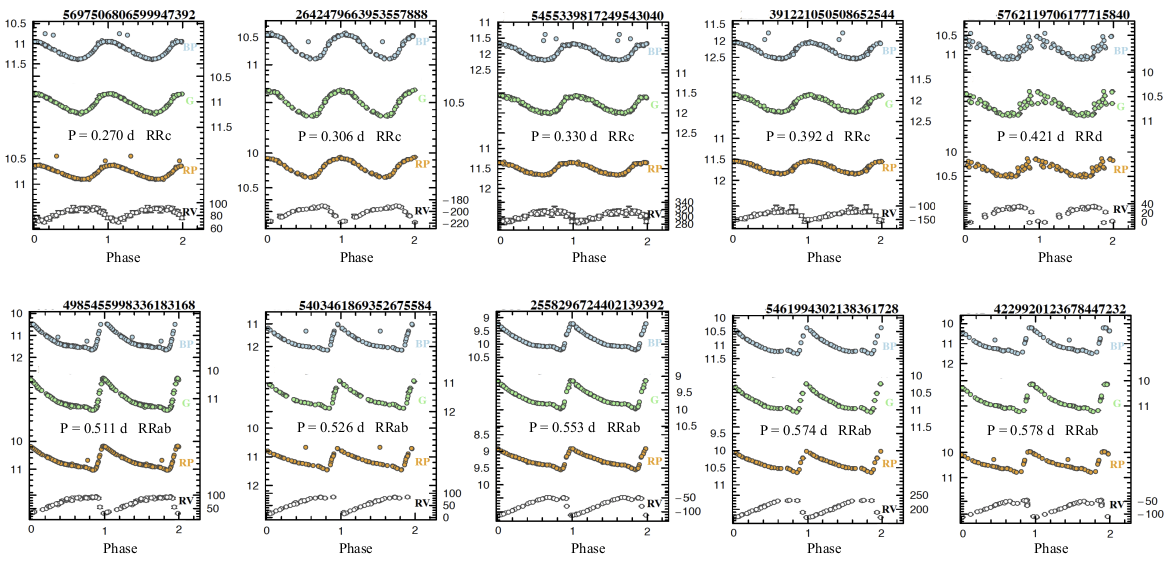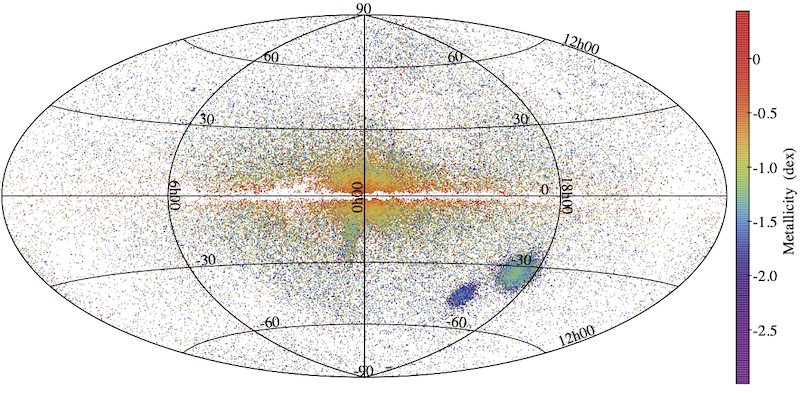IoW_20220225 - Gaia
Image of the Week
Not only distances: what Gaia DR3 RR Lyrae stars will tell us about our Galaxy and beyond
Figure 1: From top to bottom, GBP, G, GRP light curves and radial velocity (RV) curves for a sample of the RR Lyrae stars that will be released in Gaia DR3. Error bars of the photometric and radial velocity measurements are smaller than or comparable to symbol size. In the top row, the first 4 sources from left to right are c-type RR Lyrae and the fifth source is a double-mode RR Lyrae, while the five sources in the bottom row are ab-type RR Lyrae. Credit: ESA/Gaia/DPAC, CC BY-SA 3.0 IGO.
RR Lyrae are low mass (typical masses around 0.6-0.8 solar masses), old stars (ages larger than 9-10 billion years) whose surface expands and contracts regularly with periods shorter than one day. The pulsation gives rise to a variation of brightness occurring in two main flavours. First of all, the c-type RR Lyrae (RRc) have sinusoidal light curves, that repeat in time with periodicities typically between about 5 hours (or 0.2 days) and 10 hours (or 0.42 days) and an amplitude of about half a magnitude in the optical. RRc stars pulsate in the first overtone pulsation mode. Secondly, the ab-type RR Lyrae (RRab) have asymmetrical, sawtooth light curves, periods typically between about 10 hours (~ 0.42 days) and 17-20 hours (~0.71-0.83 days), and visual amplitudes around one magnitude. They pulsate in the fundamental pulsation mode. In a small fraction of RR Lyrae, fundamental and first overtone pulsation modes are excited at the same time, giving rise to the double-mode (d-type) RR Lyrae (RRd).
The characteristic light variation makes RR Lyrae easily recognized even in severe crowding or high extinction conditions, and their pulsation characteristics (periods, amplitudes, mean magnitudes/colours etc) allow an estimate of their metallicity and reddening, thus bringing invaluable added values. These stars allow to measure the distance to the systems they live in as they follow a luminosity (absolute magnitude) – metallicity relation in the optical and a period – luminosity (absolute magnitude) relation in the infrared. RR Lyrae stars are also excellent tracers of the oldest stars which witnessed the first epoch of galaxy formation, thus can provide hints on the "building blocks" that contributed to the build up of galactic halos.
With the second instalment of Gaia Data Release 3 (Gaia DR3) in June 2022, multiband light curves will be released for more than 270,000 RR Lyrae stars that have been confirmed and fully characterised by the Specific Object Study pipeline for Cepheids and RR Lyrae (called SOS Cep&RRL) developed by the Gaia Coordination Unit 7 (CU7; variability processing) of the Gaia Data Processing and Analysis Consortium. Periods, amplitudes of the GBP, G and GRP light variations, and mean magnitudes computed as an intensity-average over the full pulsation cycle will be published for these RR Lyrae stars, along with the φ21, φ31, R21 and R31 parameters of the Fourier decomposition of their G-band light curves. The Gaia DR3 sample will represent the largest, homogeneous catalogue of all-sky RR Lyrae ever released.
For a small sample, comprising slightly more than a thousand RR Lyrae with mean G magnitude between 7.6 and 14.3 mag, epoch radial velocities measured by the Radial Velocity Spectrometer (RVS) on board Gaia and, amplitude and mean value of the radial velocity curves computed by the SOS Cep&RRL pipeline, will also be released. Figure 1 shows, from top to bottom, the Gaia DR3 GBP, G, GRP light curves and the radial velocity (RV) curves of RR Lyrae stars in this sample that have pulsation period in the range from 0.270 to 0.578 days. The radial velocity curves have the typical shape compared to the light curves with the minimum value in radial velocity corresponding to maximum star brightness.
The figure shows the nice sampling and excellent quality of the epoch photometry and radial velocity measurements for bright RR Lyrae stars in Gaia DR3. A few outliers not efficiently removed by the outlier removal operator of the general CU7 pipeline are still present in the GBP and GRP light curves. However, they do not affect the modeling of the light curves and the derivation of amplitudes and mean magnitudes of these variable sources.
For about 134,000 of the RR Lyrae stars that will be released in Gaia DR3 an estimate of the metal abundance has been derived from the pulsation period and the φ31 Fourier parameter of the G-band light curve. Figure 2 shows a map of the metallicity distribution defined by these 134,000 RR Lyrae stars.
An evaluation of the interstellar absorption in the G-band was also obtained for about 140,000 of the DR3 RR Lyrae sample from the relation existing between the RR Lyrae intrinsic colour, the pulsation period and the amplitude of the light variation in the G-band, according to the procedures described in Clementini et al. (2016, 2019). See Clementini et al. (2022), the paper describing the specific processing and validation of all-sky RR Lyrae stars released in Gaia DR3, for full details.
Figure 2: Map in galactic coordinates of about 134,000 RR Lyrae stars that will be released in Gaia DR3 for which an estimate of metallicity was obtained from the pulsation period and the φ31 Fourier parameter of the G-band light curve. The sources are colour-coded according to their metallicity ([Fe/H]) as encoded in the colour-bar on the right. The two Magellanic Clouds are easily recognized in the bottom-right portion of the map. The Sagittarius dwarf spheroidal galaxy popping out just below to the left from the centre of the map can also be clearly seen. The higher metallicity of the RR Lyrae stars in the Milky Way bulge compared to variables in the Galactic halo can easily be appreciated, as it is also clear the lower metal abundance of the RR Lyrae stars in the Small Magellanic Cloud compared to the variables in the Large Magellanic Cloud. Credit: ESA/Gaia/DPAC, CC BY-SA 3.0 IGO.
Gaia Data Release 3
With the release of Gaia DR3 on 13 June 2022, a set of RR Lyrae variable stars can be expected. Below some more details are given on what to expect.
|
What can be expected in Gaia DR3? |
Expected amount |
| Total number of RR Lyrae from classification | ~297,000 |
| Total number of RR Lyrae from the Specific Object Study (SOS) pipeline | ~270,000 |
| Metallicity [Fe/H] for RR Lyrae out of the SOS RR Lyrae sample | ~134,000 |
| Absorption in the G-band for RR Lyrae out of the SOS RR Lyrae sample | ~143,000 |
| RVS radial velocity time series data for RR Lyrae out of the SOS RR Lyrae sample | ~1,100 |
Credits: ESA/Gaia/DPAC/CU7/CU6/CU5/INAF, Gisella Clementini, Alessia Garofalo, Tatiana Muraveva (INAF-OAS Bologna), Vincenzo Ripepi, Roberto Molinaro, Silvio Leccia (INAF-OACn Naples), and the CU7/DPCG, CU5, and CU6 teams.
[Published: 25/02/2022]
- Removed a total of (11) style text-align:center;
- Removed a total of (5) style text-align:right;
- Removed a total of (18) style text-align:justify;
- Removed a total of (1) align=center.
- Removed a total of (1) border attribute.
- Removed a total of (1) cellpadding attribute.
- Removed a total of (1) cellspacing attribute.
Image of the Week Archive
- Removed a total of (1) border attribute.
- Removed a total of (1) cellpadding attribute.
- Removed a total of (1) cellspacing attribute.








































 Sign in
Sign in
 Science & Technology
Science & Technology

